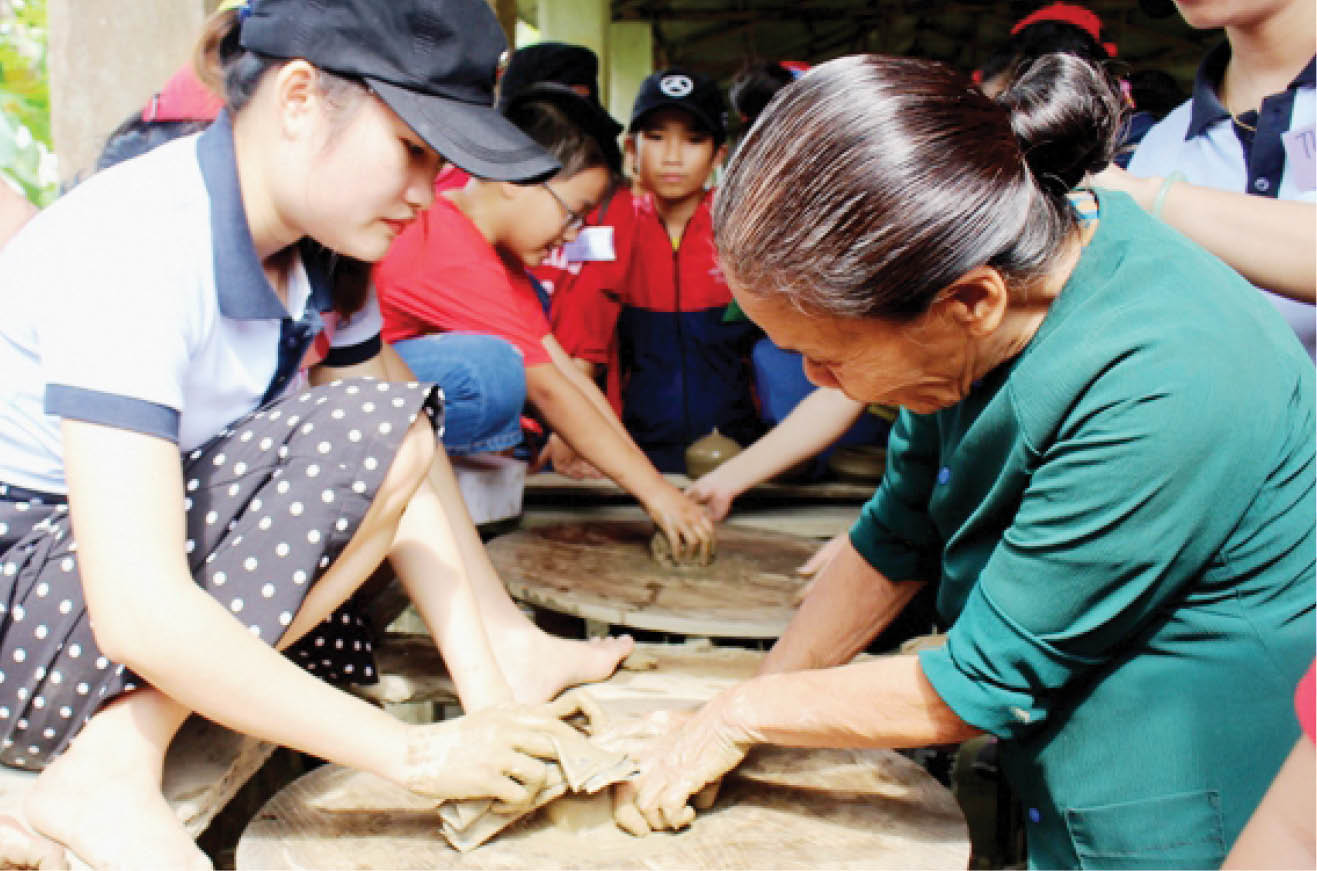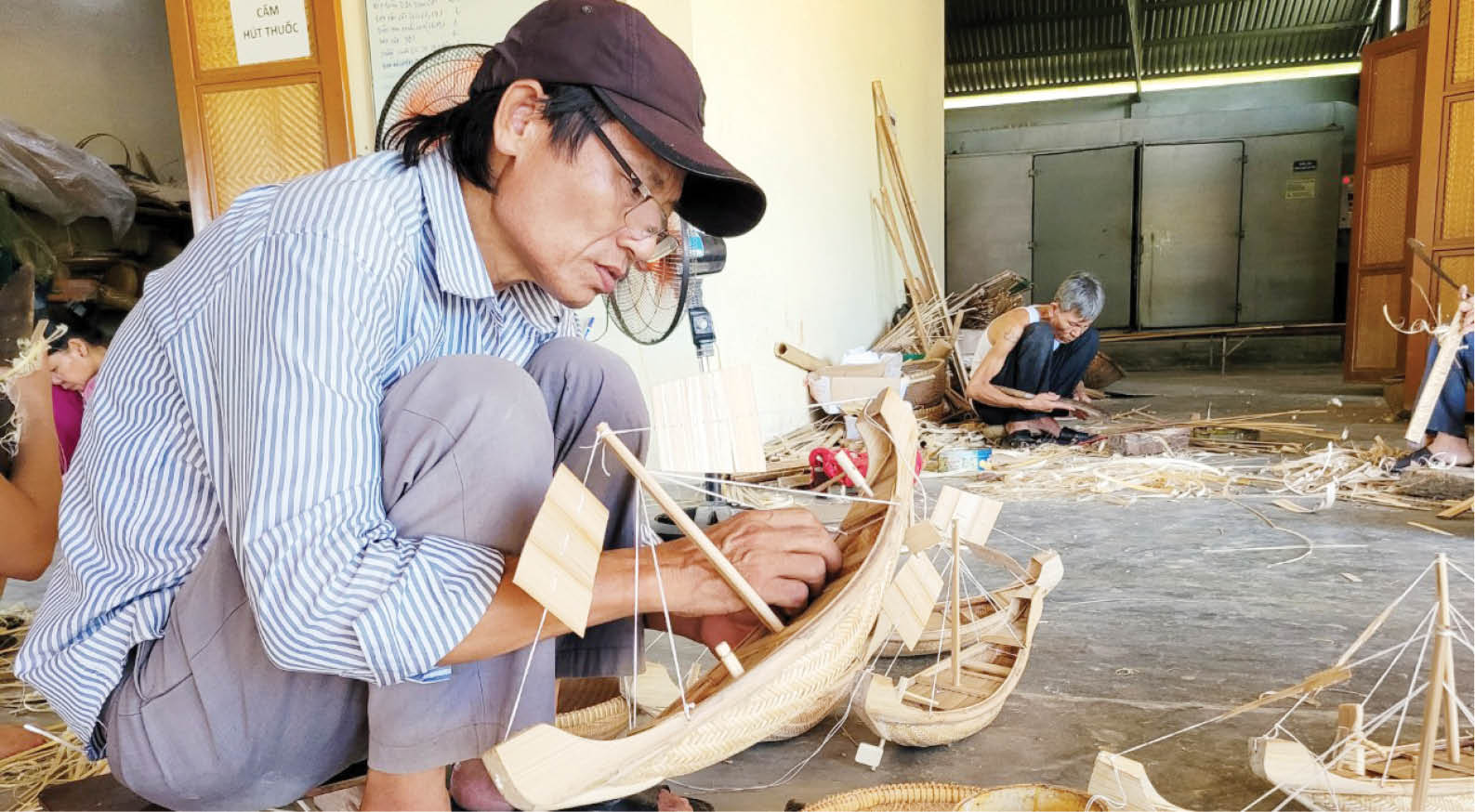Independent ways of operating, small-scale advertising, and lack of market information make it difficult for many establishments and households in craft villages to find the market for their products.

Visitors experiencing pottery making in Phuoc Tich
Unstable output
Despite having more than 60 years of experience working with bamboo and rattan and 10 years of being recognized by the Provincial People's Committee as a traditional craftsman, Mr. Thai Phi Hung, an artisan who designs and produces souvenirs and handicrafts in Bao La Bamboo and Rattan Cooperative, only has a salary of 5 million VND/month, equivalent to the income of an ordinary craftsman.
“Because most of the products are handmade, it takes a lot of work, and the price is low because there are too many products from competing craft villages in the country, so the income cannot be higher. Well, since I am passionate about the profession, I must accept to put aside the income to continue to pursue it," said Mr. Thai Phi Hung.
Bamboo and rattan handicraft "live on" in Quang Dien since the day Bao La and Thuy Lap Bamboo and Rattan Cooperatives restored and developed the profession. Currently, Bao La Bamboo and Rattan Cooperative employ more than 100 employees, with annual revenue of more than 4 billion VND.
In order to affirm the brand and to attract customers, in the past time, the People's Committee of the province, Quang Dien district and the cooperative have invested more than 10 billion VND to build a product display house, welcome gate, renovate the grounds and upgrade equipment and machinery. However, the output for craft village products is still not as expected.
Director of Bao La Bamboo and Rattan Cooperative, Mr. Vo Van Dinh shared: “In the past, the cooperative signed contracts with enterprises in Hanoi to produce goods according to designs to export to China. Although the selling price of products was not high, the output was quite stable, so we were quite assured and not worried about lack of jobs. Since the outbreak of the COVID-19 epidemic until now, due to the decline of the Chinese market and the stagnation of exports, in the 2 years 2020, 2021 and the first 9 months of this year, products were difficult to consume. The cooperative has to look for sources of retail customers and tourists to maintain jobs for the cooperative members”.
According to Mr. Dinh, because the consumption of the goods is low and the orders are not consistent, production is moderate, leading to lower salaries, ranging from 3.5 to 4 million VND/person/month. This is also the reason why the cooperative has not been able to invest in designing packaging to improve the value of the product, and at the same time to serve tourists; so, the sales channel at the cooperative is also struggling.
Hue City is one of the localities with many traditional crafts and craft villages such as Thanh Tien paper flowers village, Sinh paintings village (Phu Mau), embroidery village (Thuan Loc), bronze casting village (Phuong Duc Ward), etc., creating stable jobs for thousands of workers.
However, along with the fierce competition of "made in China" products, low-price mass-produced products from other domestic craft villages due to the use of modern machinery, many craft villages’ products in the area are unable to sell. They mainly rely on tourists and do not have space for display. The production in the style of independently operating.

The bamboo and rattan handicraft has been recovered, but the income of the villagers is very low due to slow consumption and low prices
The opportunity has not been grasped
Phuoc Tich Pottery, Phong Hoa Commune (Phong Dien) is one of the products revived through the 2006 Hue Festival. After more than 15 years of restoration and development, the ceramic products are increasingly sophisticated and diverse in design and are not inferior to the products of famous craft villages in the country such as Bat Trang, Chu Dau, Thanh Ha... However, the biggest difficulty of the craft village today is still the consumption stage.
The owner of the pottery facility, Mr. Luong Thanh Hien shared: “Although the People's Committee of Phong Dien district has paid attention and created favorable conditions for the villagers to promote and introduce products through the event "Old Fragrance of the Ancient Village", which was held on Hue Festival, these activities only help the establishment to promote the ceramic brand name but have not increased consumption and we have yet to sign contracts to produce large quantities".
According to Mr. Nguyen Dinh Bach, Chairman of Phong Dien District People's Committee, currently, community tourism in Phuoc Tich ancient village has been formed. This is the premise to bring visitors to the pottery village and craft villages in the area such as My Xuyen carpentry, Pho Trach bang grass mat..., but the services are still not diverse, so they have not met the needs of visitors.
The district has built and developed the brand name "Old Fragrance of the Ancient Village" for Phuoc Tich ancient village. This is an opportunity to build a distinct brand name for Phuoc Tich and promote tourists' awareness of a new tourism brand name. That is a model of pottery-making experience associated with Phuoc Tich pottery village and a model of providing food services for tourists associated with local specialties in order to create a chain of links and promote product consumption in craft villages.
The work of restoring and developing handicrafts and traditional craft villages has had many positive changes over the recent years, but it is still slow and inconsistent. Branded products are few and the consumption market is still limited. Production is mainly based on a household scale or small establishments with outdated technology and equipment.
On the other hand, the nature of joint ventures and associations in trades and craft villages is still limited; there are not many businesses and focal units selling products for craft villages. Many handicraft products, souvenirs and gifts have been carefully crafted and put on the market but have not yet met the needs of tourists due to unvaried designs, packaging, and limited quantity. Therefore, they are still not attractive and are difficult to consume.
Story and photos: Thanh Huong
(To be continued)
Part II: Building links with craft village tourism